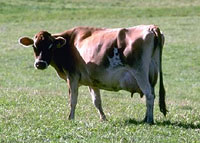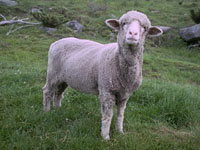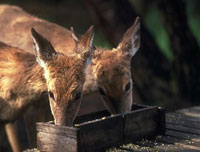Creutzfeldt-Jakob disease (known familiarly as CJD) is something you do not want to get. Your brain degenerates, piece by piece. First you feel depressed, then you have trouble coordinating. You lose sight, speech, motor control, as the disease travels through the brain. When it reaches the control centers for breathing or heartbeat, you die.
Medical science has no idea how to cure or even slow it.

Don’t get mad.
CJD used to appear mainly in people over 50, progress slowly, and be rare — though it can be misdiagnosed as Alzheimer’s disease, so it may always have been more common than we think. But over the last 10 years in Great Britain, a fast-acting strain, called nvCJD for “new variant CJD,” has been killing people as young as 15. It followed closely upon an outbreak of a disease among cows called BSE (bovine spongiform encephalopathy, otherwise known as mad cow disease). As of last week, nvCJD had killed 79 Europeans.
The link between mad cow disease and human CJD is only beginning to be understood. Both appear to be caused by an agent that isn’t a virus or bacterium or any previously recognized form of life. It seems to be a simple protein called a prion, though proteins are not supposed to be able to reproduce and go around infecting things. And — this is important to keep in mind when we come to the issue of condemned sheep in Vermont — all this science is still uncertain.
One more bit of background. Before the CJD outbreak in England, the disease was well known in only one other place in the world: New Guinea, among tribes that, well, eat each other. There it is called kuru.
Cannibalism seems to be a key factor. The mad cow outbreak may have started with the modern practice of cooking up dead sheep and using them as a cheap protein supplement in cattle feed. Sheep suffer from a brain-degenerating disease called TSE or scrapie. The theory is that somehow a scrapie prion jumped the species barrier and infected a cow. When that cow died, it too was sent to a rendering plant and turned into feed, thus spreading the disease. You need hypothesize just one more species barrier leap to suspect — not prove, just suspect — that beef from mad cows causes nvCJD in humans.
Hence the European beef panic, the incineration of thousands of British cattle, the skittishness of Europeans about their food supply, and a death sentence for about 300 sheep.

Lamb to the slaughter?
The sheep in question are a special high-milk-yielding variety imported from Belgium by three Vermont families who make cheese. The European flock from which they came has never been fed animal-containing feed. Under continuous testing it has shown no sign of scrapie. The sheep brought to Vermont have been quarantined for four years.
Recently four sheep were culled from the herd and sent to the USDA for routine testing. Brain samples were sent to England, where unusual cells were found. “There was evidence that the lesions could have TSE,” says the USDA. The British experts didn’t actually say that. They said things like this: “maybe a proliferation of glial cells, suggesting a neurological condition that might or might not develop later into … disease and might or might not be infectious but that did not resemble any case of BSE or TSE in sheep.”
Upon this non-evidence, the USDA ordered the Vermont flocks destroyed, with monetary compensation to their owners. The owners are fighting for their sheep’s lives. The matter is in court. The sheep police are poised to descend at any moment. Demonstrators gather at the farms.
We obviously have a bureaucracy in overdrive here. I might be more impressed at its zeal, if it were not the same bureaucracy that has for decades blessed the practice of raising meat animals in huge concentration camps and that still allows those animals to be fed with hormones, antibiotics, and dead animals. (The USDA did not take serious steps to ban animal products in feed until 1997; U.S. laws about that are still less strict than European laws.)

Oh deer!
I would be more impressed if the authorities would continue to keep an eye on those Vermont sheep, but expend its executionary energy on farm-raised deer and elk, which seem to be suffering a TSE epidemic in our western states.
I would like to direct some USDA precautionary fervor toward genetically engineered crops and animals, which it tends to pronounce safe at the drop of a biotech company’s campaign contribution.
Speaking of campaign contributions, if you follow the money, you come to an easy explanation of why the USDA is coming down like thunder on three small sheep farms while winking at the gross risks taken every day by the feedlot industry. U.S. cattlegrowers are worried sick that what happened in Britain could happen here — by which they mean not so much the public health risk as the public perception that beef is unsafe. They’re pointing at Vermont sheep to distract attention from their own practices. The USDA is acting not for us, but for them.


